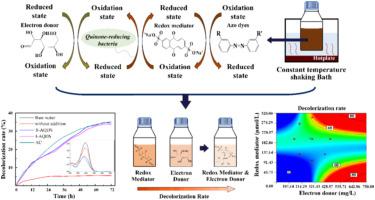Chemosphere ( IF 8.8 ) Pub Date : 2021-02-20 , DOI: 10.1016/j.chemosphere.2021.130025 Weizhu Zhou , Xiaoguang Chen , Muhammad Ismail , Liang Wei , Baolan Hu

|
During anaerobic treatment of azo dye wastewater, the decolorization efficiency is low and dissolved redox mediators (RMs) added to the system are easy lost. In order to solve these issues, immobilized RMs have been a hot area of research. In this study a novel immobilized RM material, disodium anthraquinone-2,6-disulfonate (AQDS)-chitosan globules, which is natural, highly efficient and environmentally friendly, was prepared. Compared with natural immobilized RMs (activated carbon) and dissolved RMs (AQDS), it can be considered that it has a significant strengthening effect on the anaerobic biological degradation and decolorization of azo dye wastewater. An electron donor (ED, glucose) or RM (AQDS solution) was dosed into an anaerobic reactor to determine the enhancing effect and appropriate concentration for the decolorization treatment. The results indicate that a certain concentration of ED or RM [300 mg/L (1.667 mmol/L) glucose or 200 μmol/L AQDS solution] can improve effectively the anaerobic biological degradation and decolorization effect of azo dye wastewater. While by adding both 300 mg/L (1.667 mmol/L) glucose and 300 μmol/L AQDS (the concentrations were the initial reactive concentrations) together the decolorization efficiency was improved further. At the same time, the synergy of ED (glucose) and RM (AQDS solution) on the anaerobic decolorization of azo dye was simulated by the central combination design. A mathematical model for the decolorization efficiency has been established. According to this model, the hydraulic retention time of the best decolorization speed and efficiency has been obtained.
中文翻译:

模拟电子给体和不同氧化还原介体在偶氮染料厌氧脱色上的协同作用:AQDS-壳聚糖小球可以代替传统的氧化还原介体吗?
在偶氮染料废水的厌氧处理过程中,脱色效率低,添加到系统中的溶解氧化还原介体(RM)容易丢失。为了解决这些问题,固定式RM已成为研究的热点。在这项研究中,制备了一种新型的固定化RM材料,即天然,高效和环境友好的蒽醌-2,6-二磺酸二钠(AQDS)-壳聚糖小球。与天然固定的RMs(活性炭)和溶解的RMs(AQDS)相比,可以认为它对偶氮染料废水的厌氧生物降解和脱色具有显着的增强作用。将电子给体(ED,葡萄糖)或RM(AQDS溶液)加入厌氧反应器中,以确定增强效果和用于脱色处理的合适浓度。结果表明,一定浓度的ED或RM [300 mg / L(1.667 mmol / L)葡萄糖或200μmol/ L AQDS溶液]可以有效改善偶氮染料废水的厌氧生物降解和脱色效果。通过同时添加300 mg / L(1.667 mmol / L)葡萄糖和300μmol/ L AQDS(浓度是初始反应浓度),可以进一步提高脱色效率。同时,通过中心组合设计模拟了ED(葡萄糖)和RM(AQDS溶液)对偶氮染料厌氧脱色的协同作用。建立了脱色效率的数学模型。根据该模型,获得了最佳脱色速度和效率的水力停留时间。667 mmol / L)葡萄糖或200μmol/ L AQDS溶液]可有效改善偶氮染料废水的厌氧生物降解和脱色效果。通过同时添加300 mg / L(1.667 mmol / L)葡萄糖和300μmol/ L AQDS(浓度是初始反应浓度),可以进一步提高脱色效率。同时,通过中心组合设计模拟了ED(葡萄糖)和RM(AQDS溶液)对偶氮染料厌氧脱色的协同作用。建立了脱色效率的数学模型。根据该模型,获得了最佳脱色速度和效率的水力停留时间。667 mmol / L)葡萄糖或200μmol/ L AQDS溶液]可有效改善偶氮染料废水的厌氧生物降解和脱色效果。通过同时添加300 mg / L(1.667 mmol / L)葡萄糖和300μmol/ L AQDS(浓度是初始反应浓度),可以进一步提高脱色效率。同时,通过中心组合设计模拟了ED(葡萄糖)和RM(AQDS溶液)对偶氮染料厌氧脱色的协同作用。建立了脱色效率的数学模型。根据该模型,获得了最佳脱色速度和效率的水力停留时间。


























 京公网安备 11010802027423号
京公网安备 11010802027423号